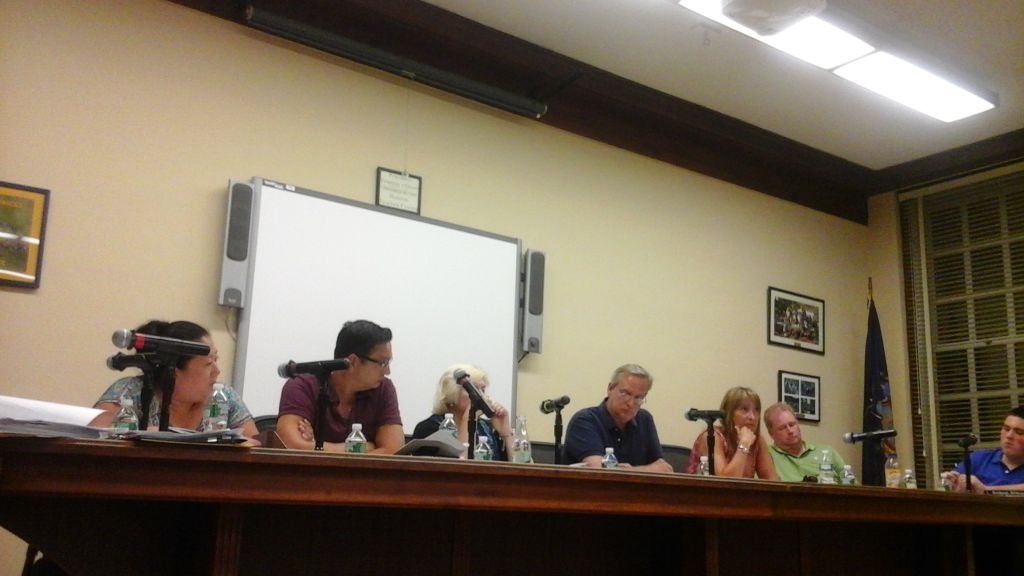The Herricks Board of Education announced last Thursday a reduction in the district’s tax levy for the 2015-16 school year of nearly $300,000 — from $94.9 million to $94.6 million.
The decrease in the tax levy will result in a tax levy increase for district residents of 1.37 percent rather than the 1.62 percent proposed in May.
Assistant Superintendent of Business Helen Costigan said the decrease in the tax levy was a result of “favorable contracts” and a ‘reduction in the Teachers Retirement System contribution rate.’
District officials said the reduction in the tax levy was part of a $1.44 million savings to taxpayers — 20 percent more than initially estimated in May when the budget was approved, district officials said.
Costigan noted that although the tax increase percentage is reduced, the amount of dollars saved by residents will vary depending on their individual tax assessments.
“If everyone’s tax assessment remains the same then the increase will remain at 1.37,” Costigan said.
The board also announced at the meeting that it established a capital reserve fund holding $1.5 million that was approved by voters in May.
Costigan said the capital reserve fund will be used for building repairs mandated by the state when it conducts a building condition survey this year.
“Once we see [the results of the survey], we can look into our capital reserves and what funds are in there,” Costigan said. “Only with the vote of the public are we able to take any of those funds and work towards any of the improvements that need to be made based on the observations of the architect.”
In his budget recommendations, then Superintendent of Schools John Bierwirth said establishing a capital reserve would allow Herricks to “address at least some major capital projects in a more flexible and timely manner.”
“Instead of waiting for something to become irreparable and, thereby, become eligible to be replaced on an emergency basis or…put out a bond, the district would be able to tap the reserve,” Bierwirth said in a memo.
The capital reserve fund can hold a maximum of $5 million over a 10-year period.
“You have to something in the bank just in case for a rainy day,” said District Superintendent Fino Celano, who replaced Beirwirth following his retirement at the end of June. “The district has to reserves in place so that in those difficult times, there’s an opportunity to fund those emergencies.”
Board member Jim Gounaris said the $1.5 million set for the capital reserve fund was a ‘prudent’ figure. He added that the board should send its rebate to taxpayers as soon as it has it.
“At the end this is all the resident’s money, it’s not our money,” Trustee Jim Gounaris said. “I understand how we should squirrel some of this money away because at the end, we wind up saving some money.”
Fellow Trustee Brian Hassan said that if the state tax cap drops to under 1 percent, it will result in a $900,000 decrease in revenue for the district.
Hassan argued that to compensate for the decrease and the potential increase to pension payments the board should limit the money invested in the capital reserve fund.
“We just have to be careful because we’re really underfunded in the long term,” Hassan said. “I’m okay with $1.5 million, I just don’t want to go too low and then have to put a five-year plan in place again to not have to make cuts.”
The reduced tax levy and the increase in the amount of money that the board can give to residents also coincides with a 13 percent increase in state aid the district is set to receive for the next fiscal year.
The board said in April that it would hold off on allocating the funds until its teacher evaluation plans are approved by the state in November. In an e-mail, a board spokeswoman board said the increase in state aid did not have an effect on the additional savings.
The board will also add $583,000 to its Workers Compensation Reserve Fund and more than $202,000 to its Employee Benefit – Compensated Absences Fund according to formulas it internally set. Both funds are at their respective caps set at $2.2 million and $1.7 million, respectively.
In other developments,
• The board approved a contract with Columbia University for professional development services in reading and writing for teachers K-8. Columbia is the sole provider of the Reading and Writing Project Network provides guidance and support for teachers looking to implement Common Core standards in literacy and writing.
• The board renewed its lease with the Young Indian Culture Group that allows the group to use the Middle School on Saturdays. The rent for the 2015-16 school year is $37,681 and will increase by 1.75 percent each year through 2019-2020.
• The board awarded $3.5 million in bonds to Janney Montgomery Scott LLC at an interest rate of about 1.5 percent. Costigan said the district locked in a low rate for the bonds which were approved by voters in 2014 to go to the repair boilers and roofs within the district.
• Athletic director Jim Petricca attended the meeting and discussed the potential installation of a turf field and renovations at the high school. Petricca said the preliminary costs of installing the turf field and renovating the bleachers would be $1.3 million and $800,000, respectively.



